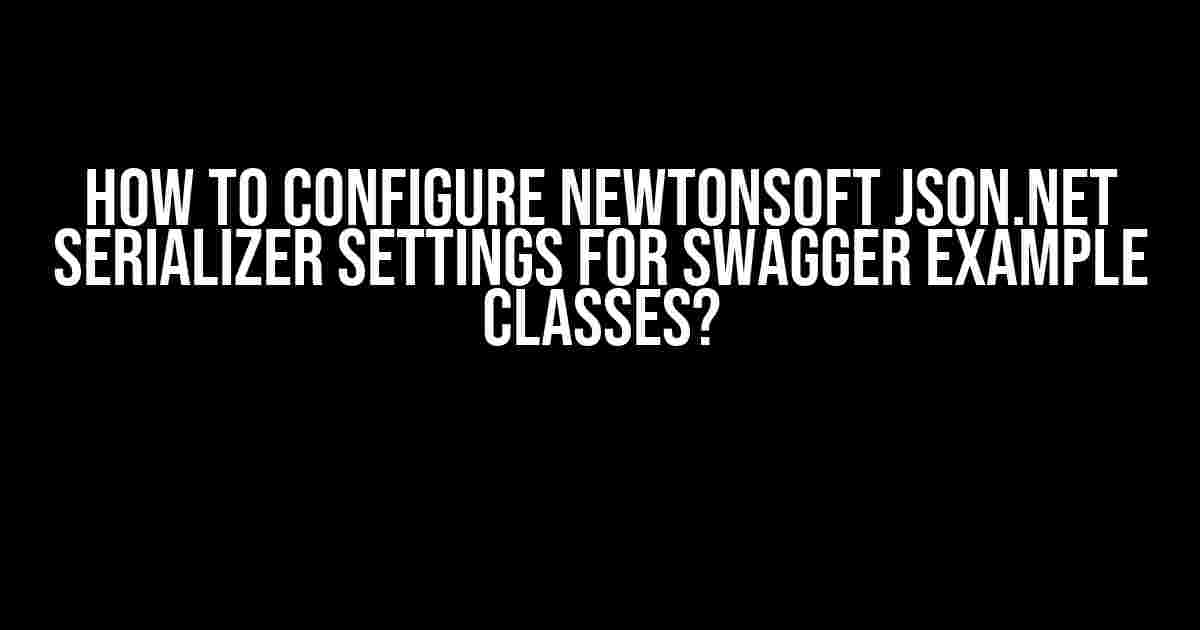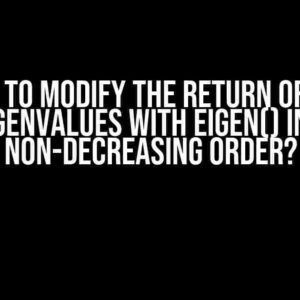Swagger is an increasingly popular tool for documenting and testing API endpoints. When using Newtonsoft JSON.NET as your serializer, you might encounter issues with serialization and deserialization of complex objects. In this article, we’ll dive into the world of Newtonsoft JSON.NET serializer settings and explore how to configure them for Swagger example classes.
Why Do We Need Newtonsoft JSON.NET Serializer Settings?
In Swagger, JSON.NET is used as the default serializer. However, when dealing with complex objects, you might need to fine-tune the serializer settings to achieve the desired serialization and deserialization results. This is where Newtonsoft JSON.NET serializer settings come into play.
By configuring the serializer settings, you can:
- Control the serialization of properties, such as ignoring certain properties or renaming them.
- Determine the conversion of data types, like converting enums to strings or integers.
- Specify the serialization of complex objects, including nested objects and arrays.
- Customize the serialization of dates and times to match your application’s requirements.
Setting Up Newtonsoft JSON.NET Serializer Settings
To get started, you’ll need to install the Newtonsoft.Json NuGet package in your .NET project:
Install-Package Newtonsoft.JsonNext, create a new instance of the JsonSerializerSettings class, which will hold your custom serializer settings:
var settings = new JsonSerializerSettings();Ignoring Properties
Sometimes, you might want to ignore certain properties during serialization. For example, you might have a property that contains sensitive information, like a password. To ignore a property, use the _Default property of the JsonSerializerSettings class:
settings.DefaultValueHandling = DefaultValueHandling.Ignore;This will ignore all default-valued properties during serialization.
Rename Properties
You can also rename properties to match your API’s naming conventions. To do this, use the ContractResolver property:
settings.ContractResolver = new DefaultContractResolver
{
NamingStrategy = new CamelCaseNamingStrategy()
};This will convert property names to camelCase.
Converting Enums
When working with enums, you might want to convert them to strings or integers. To do this, use the StringEnumConverter class:
settings.Converters.Add(new StringEnumConverter());This will convert enums to strings during serialization.
Customizing Serialization of Complex Objects
To customize the serialization of complex objects, you can use the JsonConverter class. For example, let’s say you have a Person class with a Address property:
public class Person
{
public string Name { get; set; }
public Address Address { get; set; }
}
public class Address
{
public string Street { get; set; }
public string City { get; set; }
public string State { get; set; }
public string Zip { get; set; }
}To customize the serialization of the Address property, you can create a custom converter:
public class AddressConverter : JsonConverter<Address>
{
public override void WriteJson(JsonWriter writer, Address value, JsonSerializer serializer)
{
writer.WriteStartObject();
writer.WritePropertyName("street");
writer.WriteValue(value.Street);
writer.WritePropertyName("city");
writer.WriteValue(value.City);
writer.WritePropertyName("state");
writer.WriteValue(value.State);
writer.WritePropertyName("zip");
writer.WriteValue(value.Zip);
writer.WriteEndObject();
}
public override Address ReadJson(JsonReader reader, Type objectType, Address existingValue, bool hasExistingValue, JsonSerializer serializer)
{
var address = new Address();
while (reader.Read())
{
if (reader.TokenType == JsonToken.PropertyName)
{
string propertyName = reader.Value.ToString();
reader.Read();
switch (propertyName)
{
case "street":
address.Street = reader.Value.ToString();
break;
case "city":
address.City = reader.Value.ToString();
break;
case "state":
address.State = reader.Value.ToString();
break;
case "zip":
address.Zip = reader.Value.ToString();
break;
}
}
}
return address;
}
}Then, add the converter to the serializer settings:
settings.Converters.Add(new AddressConverter());Customizing Serialization of Dates and Times
By default, JSON.NET serializes dates and times in the ISO 8601 format. However, you can customize this to match your application’s requirements. For example, to serialize dates in the “yyyy-MM-dd” format, use the DateFormatString property:
settings.DateFormatString = "yyyy-MM-dd";Applying Newtonsoft JSON.NET Serializer Settings to Swagger
Now that we’ve configured our serializer settings, let’s apply them to Swagger. First, create a new instance of the SwaggerSerializer class:
var swaggerSerializer = new SwaggerSerializer(settings);Then, add the serializer to the Swagger configuration:
c.AddSwaggerGen(options =>
{
options.Serializer = swaggerSerializer;
});Example Class: Putting it All Together
Let’s create an example class that demonstrates the application of our custom serializer settings:
public class PersonExample
{
public string Name { get; set; }
public AddressExample Address { get; set; }
public EnumExample EnumValue { get; set; }
public DateTime DateOfBirth { get; set; }
}
public class AddressExample
{
public string Street { get; set; }
public string City { get; set; }
public string State { get; set; }
public string Zip { get; set; }
}
public enum EnumExample
{
Value1,
Value2,
Value3
}In this example, we’ve applied our custom serializer settings to serialize the Address property using the custom converter, convert the EnumExample property to a string, and serialize the DateOfBirth property in the “yyyy-MM-dd” format.
| Property | Serialized Value |
|---|---|
| Name | “John Doe” |
| Address | {“street”: “123 Main St”, “city”: “Anytown”, “state”: “CA”, “zip”: “12345”} |
| EnumValue | “Value2” |
| DateOfBirth | “1990-01-01” |
By applying our custom serializer settings, we’ve achieved the desired serialization results for our example class.
Conclusion
In this article, we’ve explored the world of Newtonsoft JSON.NET serializer settings and learned how to configure them for Swagger example classes. By fine-tuning the serializer settings, you can achieve the desired serialization and deserialization results for your complex objects. Remember to apply your custom serializer settings to Swagger using the SwaggerSerializer class, and you’ll be well on your way to creating robust and scalable APIs.
Frequently Asked Questions
Get the inside scoop on configuring Newtonsoft JSON.NET serializer settings for Swagger example classes!
Q: How do I configure Newtonsoft JSON.NET serializer settings for Swagger example classes?
To configure Newtonsoft JSON.NET serializer settings, you’ll need to create a custom formatter for Swagger. You can do this by implementing the `ISerializer` interface and setting the `Serializer` property on the `SwaggerSerializer` instance. For example: `swaggerSerializer.Serializer = new NewtonsoftJsonSerializer(settings);`, where `settings` is an instance of `JsonSerializerSettings` with your desired configuration.
Q: What are some common Newtonsoft JSON.NET serializer settings I should consider for Swagger example classes?
Some common settings to consider include `NullValueHandling` (e.g., ignore or include null values), `DateFormatString` (e.g., specify a custom date format), `ReferenceLoopHandling` (e.g., handle circular references), and `Formatting` (e.g., indentation and whitespace). For example: `jsonSerializerSettings.NullValueHandling = NullValueHandling.Ignore;`
Q: How do I handle circular references in my Swagger example classes using Newtonsoft JSON.NET serializer settings?
To handle circular references, you can set `ReferenceLoopHandling` to `ReferenceLoopHandling.Serialize` or `ReferenceLoopHandling.Ignore`. The former will serialize the circular reference, while the latter will ignore it. For example: `jsonSerializerSettings.ReferenceLoopHandling = ReferenceLoopHandling.Serialize;`
Q: Can I customize the JSON serialization of specific properties in my Swagger example classes using Newtonsoft JSON.NET serializer settings?
Yes, you can use `JsonProperty` attributes on your class properties to customize their serialization. For example, to change the property name, you can use `[JsonProperty(“customPropertyName”)]`. You can also use `JsonConverter` attributes to specify a custom converter for a property.
Q: How do I integrate my custom Newtonsoft JSON.NET serializer settings with Swagger in an ASP.NET Core application?
In your ASP.NET Core application, you’ll need to add the Swagger middleware and configure it to use your custom serializer settings. You can do this by creating a custom `SwaggerSerializer` implementation and setting the `Serializer` property on the `SwaggerOptions` instance. For example: `services.AddSwaggerGen(c => c.SwaggerSerializer = new CustomSwaggerSerializer());`


